Comprehensive Project Management Report: Smart City OS Project
VerifiedAdded on 2023/06/12
|27
|7100
|493
Report
AI Summary
This report provides a comprehensive analysis of the project management aspects of the Smart City OS project, focusing on Hull's journey to becoming a programmable city. It covers essential skills for the project manager, actions for skill development, stakeholder identification and engagement strategies using the Mendelow Matrix, and the importance of project triangle parameters (scope, cost, time). The report also delves into financial management, including resource requirements and cost estimation techniques, along with a detailed risk analysis and mitigation plan. Furthermore, it addresses various types of conflicts that may arise and suggests management strategies, concluding with strategies for building a highly successful and diverse team, highlighting the benefits and challenges of diverse teams. The methodology includes infrastructure development, sensor installation, and platform implementation, contributing to a strong digital infrastructure.

Project management
Paraphrase This Document
Need a fresh take? Get an instant paraphrase of this document with our AI Paraphraser
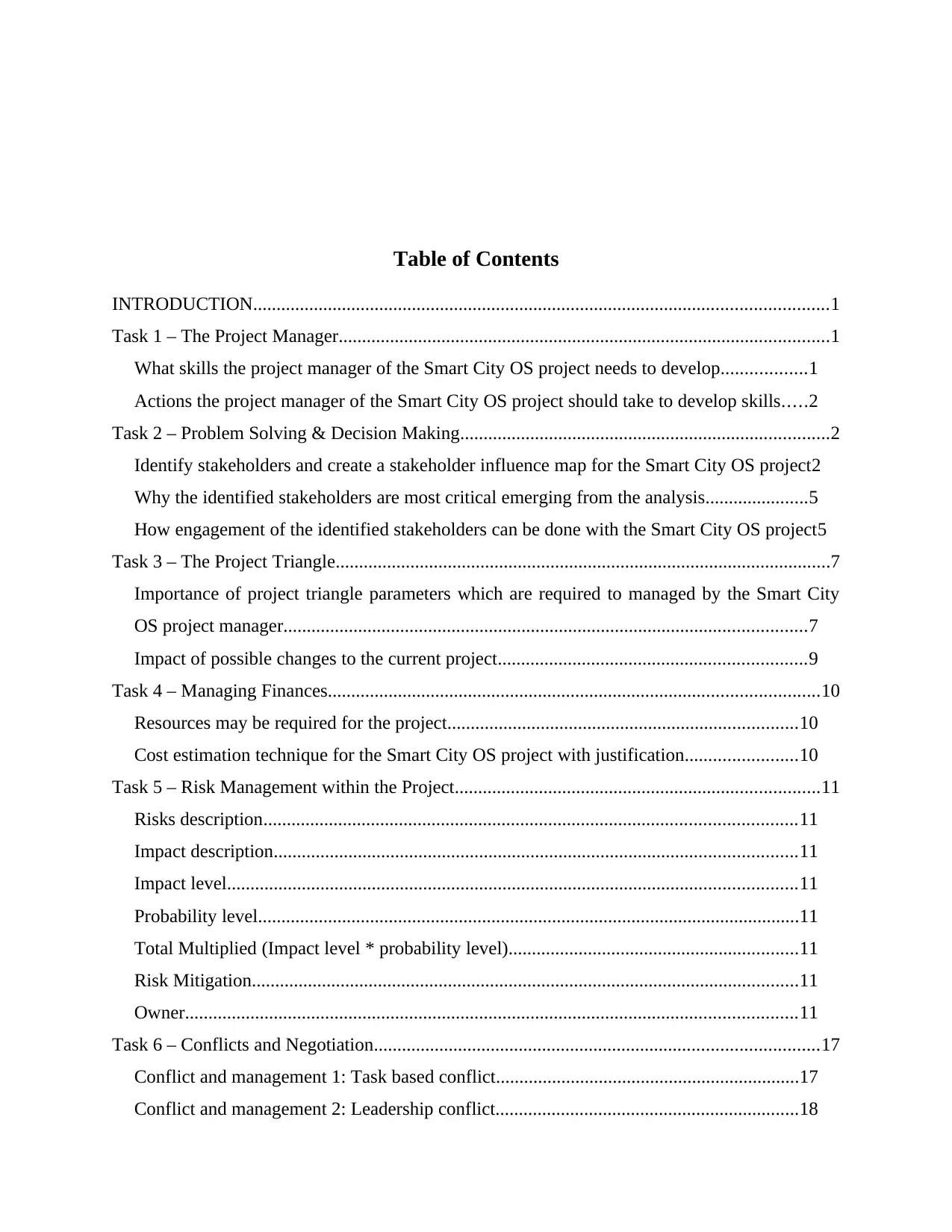
Table of Contents
INTRODUCTION...........................................................................................................................1
Task 1 – The Project Manager.........................................................................................................1
What skills the project manager of the Smart City OS project needs to develop..................1
Actions the project manager of the Smart City OS project should take to develop skills.....2
Task 2 – Problem Solving & Decision Making...............................................................................2
Identify stakeholders and create a stakeholder influence map for the Smart City OS project2
Why the identified stakeholders are most critical emerging from the analysis......................5
How engagement of the identified stakeholders can be done with the Smart City OS project5
Task 3 – The Project Triangle..........................................................................................................7
Importance of project triangle parameters which are required to managed by the Smart City
OS project manager................................................................................................................7
Impact of possible changes to the current project..................................................................9
Task 4 – Managing Finances.........................................................................................................10
Resources may be required for the project...........................................................................10
Cost estimation technique for the Smart City OS project with justification........................10
Task 5 – Risk Management within the Project..............................................................................11
Risks description..................................................................................................................11
Impact description................................................................................................................11
Impact level..........................................................................................................................11
Probability level....................................................................................................................11
Total Multiplied (Impact level * probability level)..............................................................11
Risk Mitigation.....................................................................................................................11
Owner...................................................................................................................................11
Task 6 – Conflicts and Negotiation...............................................................................................17
Conflict and management 1: Task based conflict.................................................................17
Conflict and management 2: Leadership conflict.................................................................18
INTRODUCTION...........................................................................................................................1
Task 1 – The Project Manager.........................................................................................................1
What skills the project manager of the Smart City OS project needs to develop..................1
Actions the project manager of the Smart City OS project should take to develop skills.....2
Task 2 – Problem Solving & Decision Making...............................................................................2
Identify stakeholders and create a stakeholder influence map for the Smart City OS project2
Why the identified stakeholders are most critical emerging from the analysis......................5
How engagement of the identified stakeholders can be done with the Smart City OS project5
Task 3 – The Project Triangle..........................................................................................................7
Importance of project triangle parameters which are required to managed by the Smart City
OS project manager................................................................................................................7
Impact of possible changes to the current project..................................................................9
Task 4 – Managing Finances.........................................................................................................10
Resources may be required for the project...........................................................................10
Cost estimation technique for the Smart City OS project with justification........................10
Task 5 – Risk Management within the Project..............................................................................11
Risks description..................................................................................................................11
Impact description................................................................................................................11
Impact level..........................................................................................................................11
Probability level....................................................................................................................11
Total Multiplied (Impact level * probability level)..............................................................11
Risk Mitigation.....................................................................................................................11
Owner...................................................................................................................................11
Task 6 – Conflicts and Negotiation...............................................................................................17
Conflict and management 1: Task based conflict.................................................................17
Conflict and management 2: Leadership conflict.................................................................18
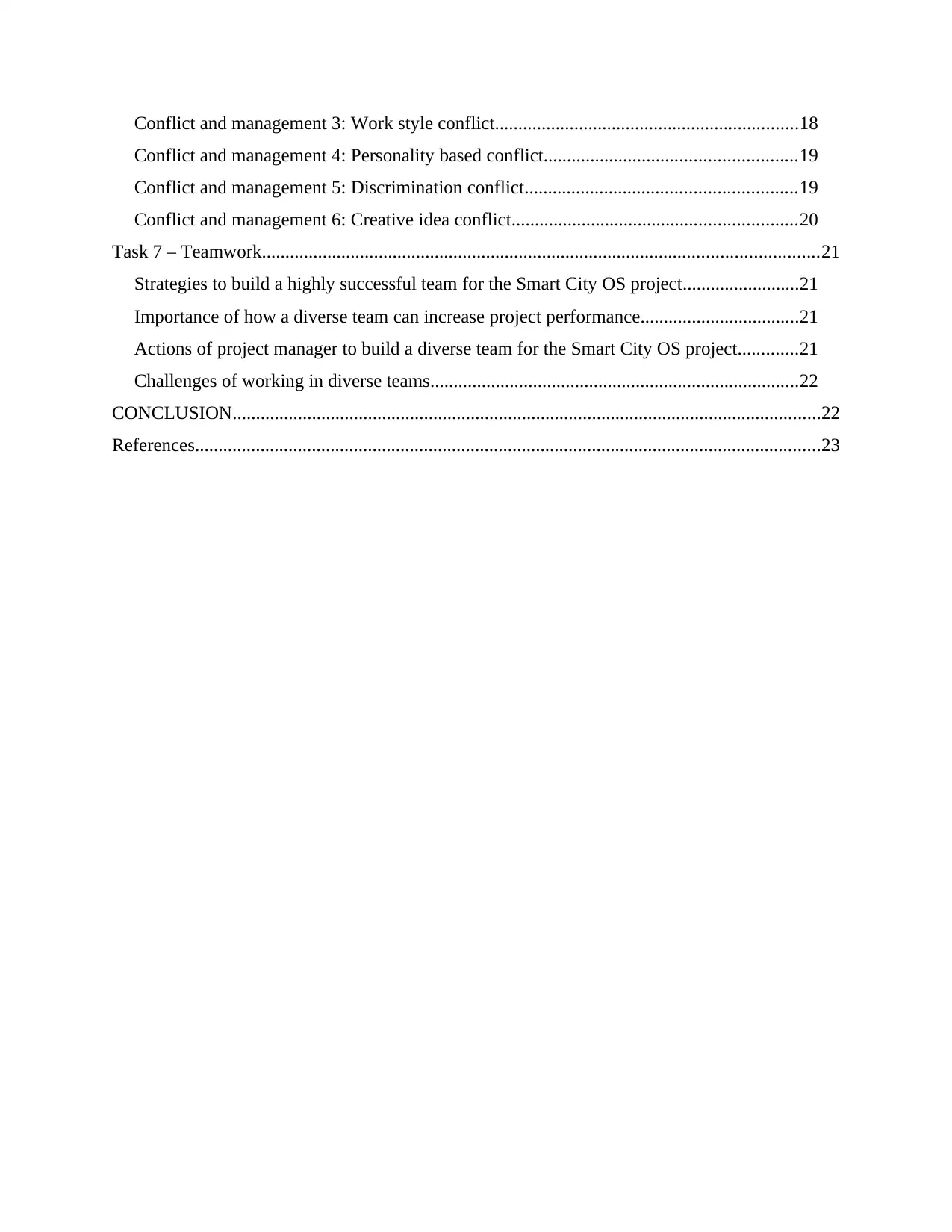
Conflict and management 3: Work style conflict.................................................................18
Conflict and management 4: Personality based conflict......................................................19
Conflict and management 5: Discrimination conflict..........................................................19
Conflict and management 6: Creative idea conflict.............................................................20
Task 7 – Teamwork.......................................................................................................................21
Strategies to build a highly successful team for the Smart City OS project.........................21
Importance of how a diverse team can increase project performance..................................21
Actions of project manager to build a diverse team for the Smart City OS project.............21
Challenges of working in diverse teams...............................................................................22
CONCLUSION..............................................................................................................................22
References......................................................................................................................................23
Conflict and management 4: Personality based conflict......................................................19
Conflict and management 5: Discrimination conflict..........................................................19
Conflict and management 6: Creative idea conflict.............................................................20
Task 7 – Teamwork.......................................................................................................................21
Strategies to build a highly successful team for the Smart City OS project.........................21
Importance of how a diverse team can increase project performance..................................21
Actions of project manager to build a diverse team for the Smart City OS project.............21
Challenges of working in diverse teams...............................................................................22
CONCLUSION..............................................................................................................................22
References......................................................................................................................................23
⊘ This is a preview!⊘
Do you want full access?
Subscribe today to unlock all pages.

Trusted by 1+ million students worldwide

INTRODUCTION
Project management can be defined as the process of undertaking a project in order to
accomplish goals of the project while leading the entire team who are involved in the project
(Bibri and Krogstie, 2020). The following discussion is based on the case scenario of the smart
city OS case study that is the Hull’s journey to becoming a programmable city. The project is to
be managed by covering the skills required in project manager to develop the project and actions
needed for the same. Moreover, stakeholder identification and their engagement is also covered
along with the project triangle parameters and its relationship among them. The below report
also provides the insight of resources required and cost estimation along with the risk analysis
and management of the risk. Discussion is also made on the different types of conflicts and its
solutions within the project management along with the strategies to build a highly successful
team and importance of how a diverse team can increase project performance. Furthermore,
actions to build a diverse team and challenges of working in diverse teams are also viewed in the
current report.
The methodology used in the current scenario for the smart City has several steps. The
first step is the infrastructure which the developers have focused on according to the range of
network connections. The second step is the installation of sensors across the city so that the
connections can be identified along with their bandwidth. The third step is the implementation of
the platform after analysing all the risks and mitigations of it. This has resulted in the strong
digital infrastructure of the smart city which has the economic benefits as well.
Task 1 – The Project Manager
What skills the project manager of the Smart City OS project needs to develop
Project manager must have the skills while working on the project of smart city OS such
as he must have the ability to clarify the goals with the team so that conflicts and confusions can
be avoided. He must encourage the open communication so that interaction level among the team
can be strategic and effective in nature (Mora, Deakin and Reid, 2019). Moreover, he must have
the leadership skills for directing the team towards right tasks and assist with any resources or
guidance as well. He must know hoe to maintain the positive atmosphere and also having the
negotiation skills along with the scheduling and time management. Risk management and
problem solving behaviour must also be a skill in project manager.
1
Project management can be defined as the process of undertaking a project in order to
accomplish goals of the project while leading the entire team who are involved in the project
(Bibri and Krogstie, 2020). The following discussion is based on the case scenario of the smart
city OS case study that is the Hull’s journey to becoming a programmable city. The project is to
be managed by covering the skills required in project manager to develop the project and actions
needed for the same. Moreover, stakeholder identification and their engagement is also covered
along with the project triangle parameters and its relationship among them. The below report
also provides the insight of resources required and cost estimation along with the risk analysis
and management of the risk. Discussion is also made on the different types of conflicts and its
solutions within the project management along with the strategies to build a highly successful
team and importance of how a diverse team can increase project performance. Furthermore,
actions to build a diverse team and challenges of working in diverse teams are also viewed in the
current report.
The methodology used in the current scenario for the smart City has several steps. The
first step is the infrastructure which the developers have focused on according to the range of
network connections. The second step is the installation of sensors across the city so that the
connections can be identified along with their bandwidth. The third step is the implementation of
the platform after analysing all the risks and mitigations of it. This has resulted in the strong
digital infrastructure of the smart city which has the economic benefits as well.
Task 1 – The Project Manager
What skills the project manager of the Smart City OS project needs to develop
Project manager must have the skills while working on the project of smart city OS such
as he must have the ability to clarify the goals with the team so that conflicts and confusions can
be avoided. He must encourage the open communication so that interaction level among the team
can be strategic and effective in nature (Mora, Deakin and Reid, 2019). Moreover, he must have
the leadership skills for directing the team towards right tasks and assist with any resources or
guidance as well. He must know hoe to maintain the positive atmosphere and also having the
negotiation skills along with the scheduling and time management. Risk management and
problem solving behaviour must also be a skill in project manager.
1
Paraphrase This Document
Need a fresh take? Get an instant paraphrase of this document with our AI Paraphraser
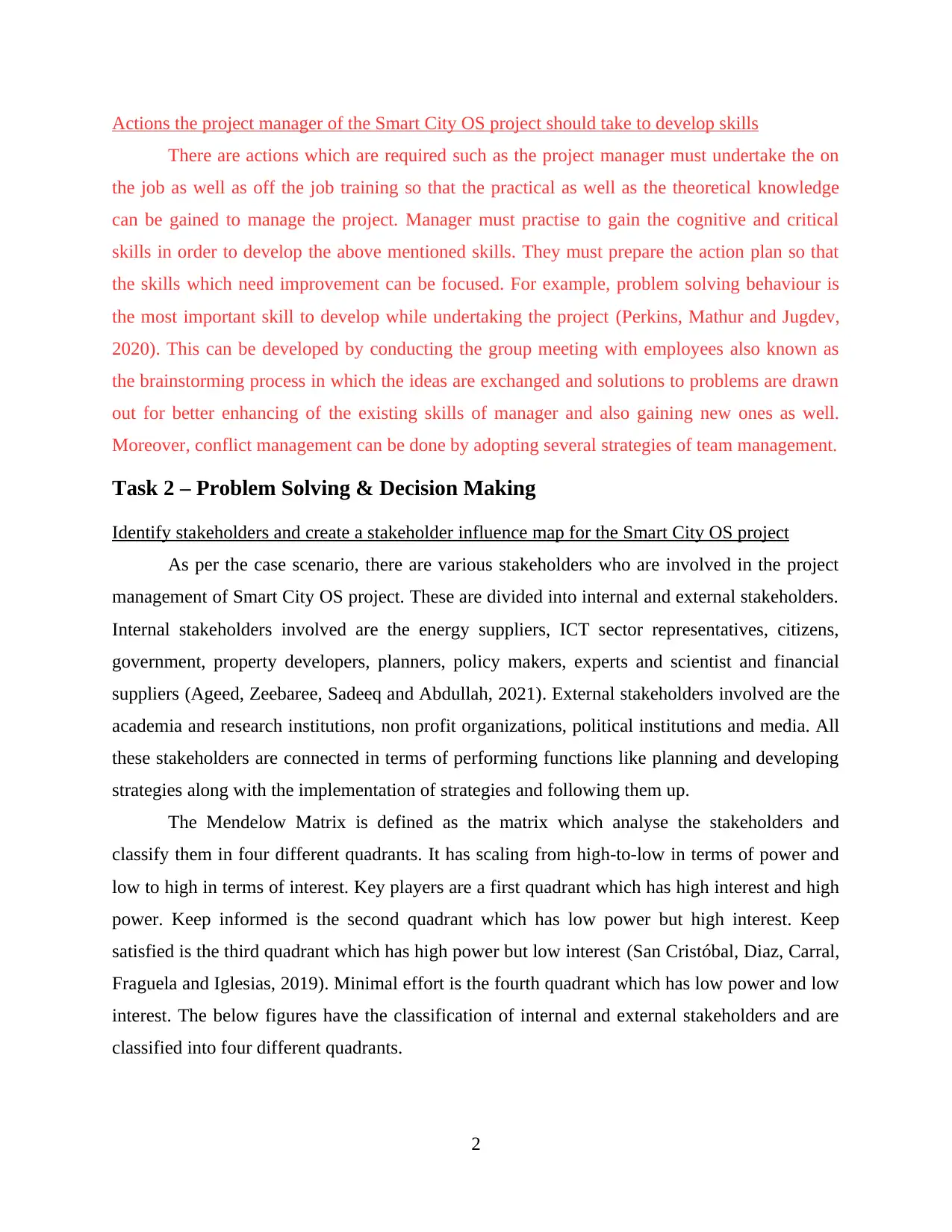
Actions the project manager of the Smart City OS project should take to develop skills
There are actions which are required such as the project manager must undertake the on
the job as well as off the job training so that the practical as well as the theoretical knowledge
can be gained to manage the project. Manager must practise to gain the cognitive and critical
skills in order to develop the above mentioned skills. They must prepare the action plan so that
the skills which need improvement can be focused. For example, problem solving behaviour is
the most important skill to develop while undertaking the project (Perkins, Mathur and Jugdev,
2020). This can be developed by conducting the group meeting with employees also known as
the brainstorming process in which the ideas are exchanged and solutions to problems are drawn
out for better enhancing of the existing skills of manager and also gaining new ones as well.
Moreover, conflict management can be done by adopting several strategies of team management.
Task 2 – Problem Solving & Decision Making
Identify stakeholders and create a stakeholder influence map for the Smart City OS project
As per the case scenario, there are various stakeholders who are involved in the project
management of Smart City OS project. These are divided into internal and external stakeholders.
Internal stakeholders involved are the energy suppliers, ICT sector representatives, citizens,
government, property developers, planners, policy makers, experts and scientist and financial
suppliers (Ageed, Zeebaree, Sadeeq and Abdullah, 2021). External stakeholders involved are the
academia and research institutions, non profit organizations, political institutions and media. All
these stakeholders are connected in terms of performing functions like planning and developing
strategies along with the implementation of strategies and following them up.
The Mendelow Matrix is defined as the matrix which analyse the stakeholders and
classify them in four different quadrants. It has scaling from high-to-low in terms of power and
low to high in terms of interest. Key players are a first quadrant which has high interest and high
power. Keep informed is the second quadrant which has low power but high interest. Keep
satisfied is the third quadrant which has high power but low interest (San Cristóbal, Diaz, Carral,
Fraguela and Iglesias, 2019). Minimal effort is the fourth quadrant which has low power and low
interest. The below figures have the classification of internal and external stakeholders and are
classified into four different quadrants.
2
There are actions which are required such as the project manager must undertake the on
the job as well as off the job training so that the practical as well as the theoretical knowledge
can be gained to manage the project. Manager must practise to gain the cognitive and critical
skills in order to develop the above mentioned skills. They must prepare the action plan so that
the skills which need improvement can be focused. For example, problem solving behaviour is
the most important skill to develop while undertaking the project (Perkins, Mathur and Jugdev,
2020). This can be developed by conducting the group meeting with employees also known as
the brainstorming process in which the ideas are exchanged and solutions to problems are drawn
out for better enhancing of the existing skills of manager and also gaining new ones as well.
Moreover, conflict management can be done by adopting several strategies of team management.
Task 2 – Problem Solving & Decision Making
Identify stakeholders and create a stakeholder influence map for the Smart City OS project
As per the case scenario, there are various stakeholders who are involved in the project
management of Smart City OS project. These are divided into internal and external stakeholders.
Internal stakeholders involved are the energy suppliers, ICT sector representatives, citizens,
government, property developers, planners, policy makers, experts and scientist and financial
suppliers (Ageed, Zeebaree, Sadeeq and Abdullah, 2021). External stakeholders involved are the
academia and research institutions, non profit organizations, political institutions and media. All
these stakeholders are connected in terms of performing functions like planning and developing
strategies along with the implementation of strategies and following them up.
The Mendelow Matrix is defined as the matrix which analyse the stakeholders and
classify them in four different quadrants. It has scaling from high-to-low in terms of power and
low to high in terms of interest. Key players are a first quadrant which has high interest and high
power. Keep informed is the second quadrant which has low power but high interest. Keep
satisfied is the third quadrant which has high power but low interest (San Cristóbal, Diaz, Carral,
Fraguela and Iglesias, 2019). Minimal effort is the fourth quadrant which has low power and low
interest. The below figures have the classification of internal and external stakeholders and are
classified into four different quadrants.
2
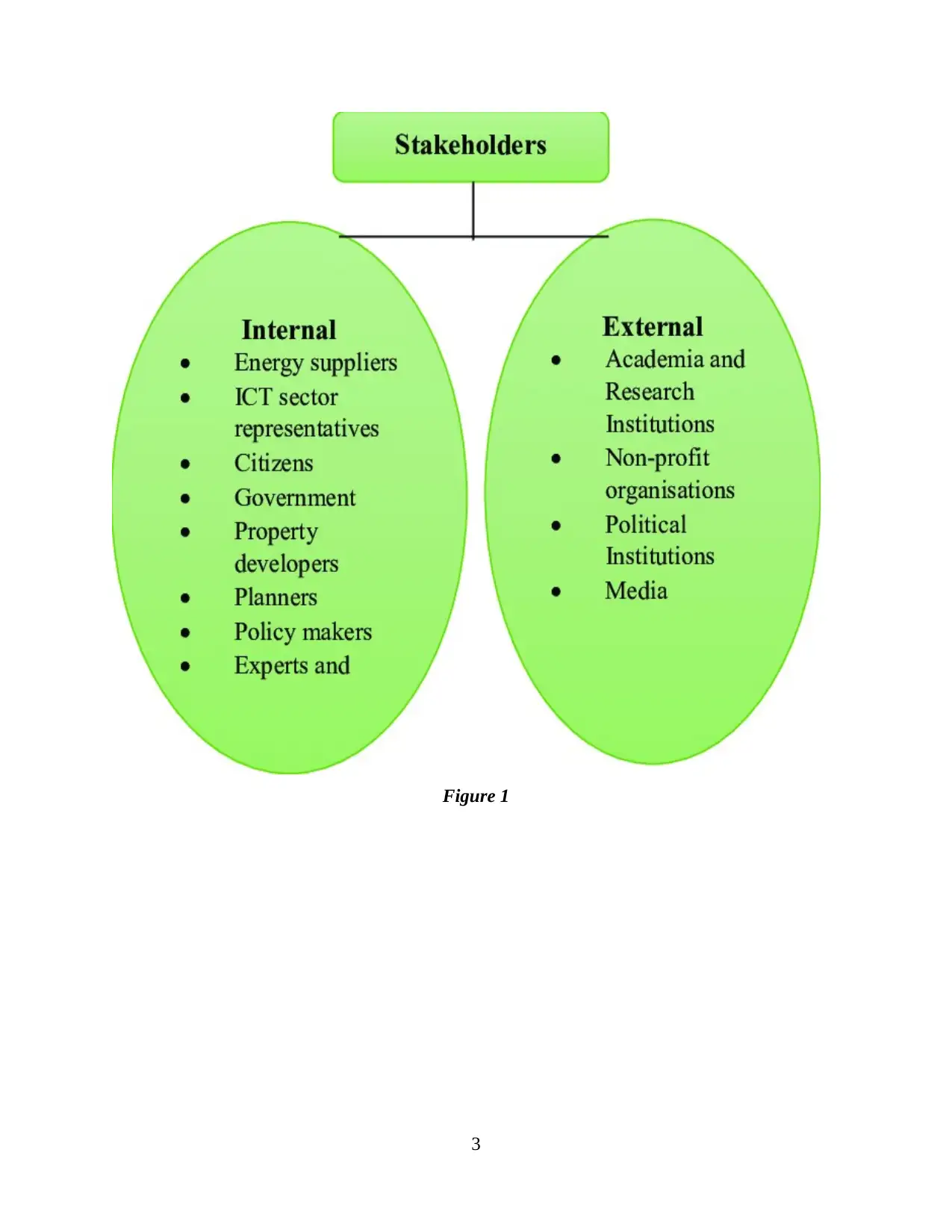
Figure 1
3
3
⊘ This is a preview!⊘
Do you want full access?
Subscribe today to unlock all pages.

Trusted by 1+ million students worldwide
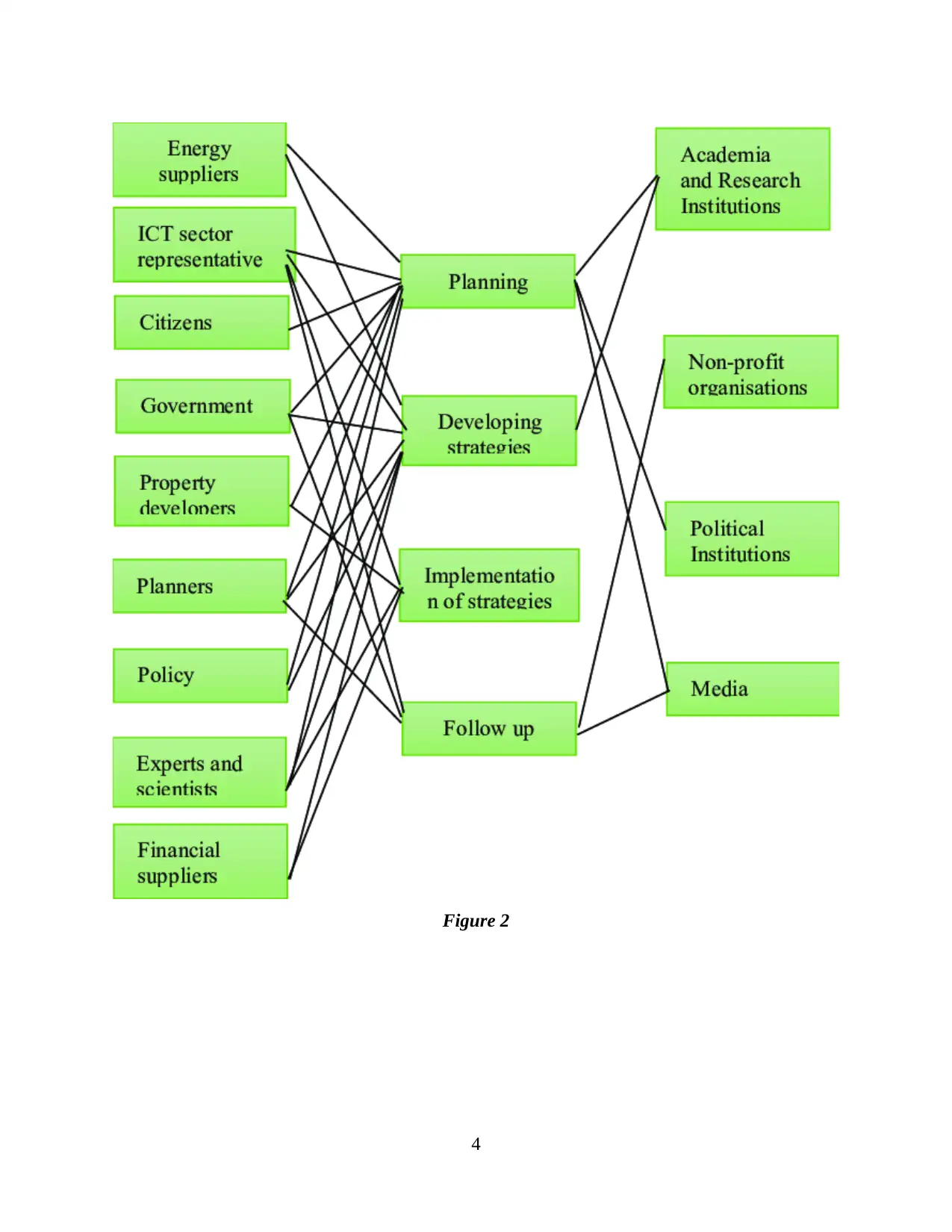
Figure 2
4
4
Paraphrase This Document
Need a fresh take? Get an instant paraphrase of this document with our AI Paraphraser
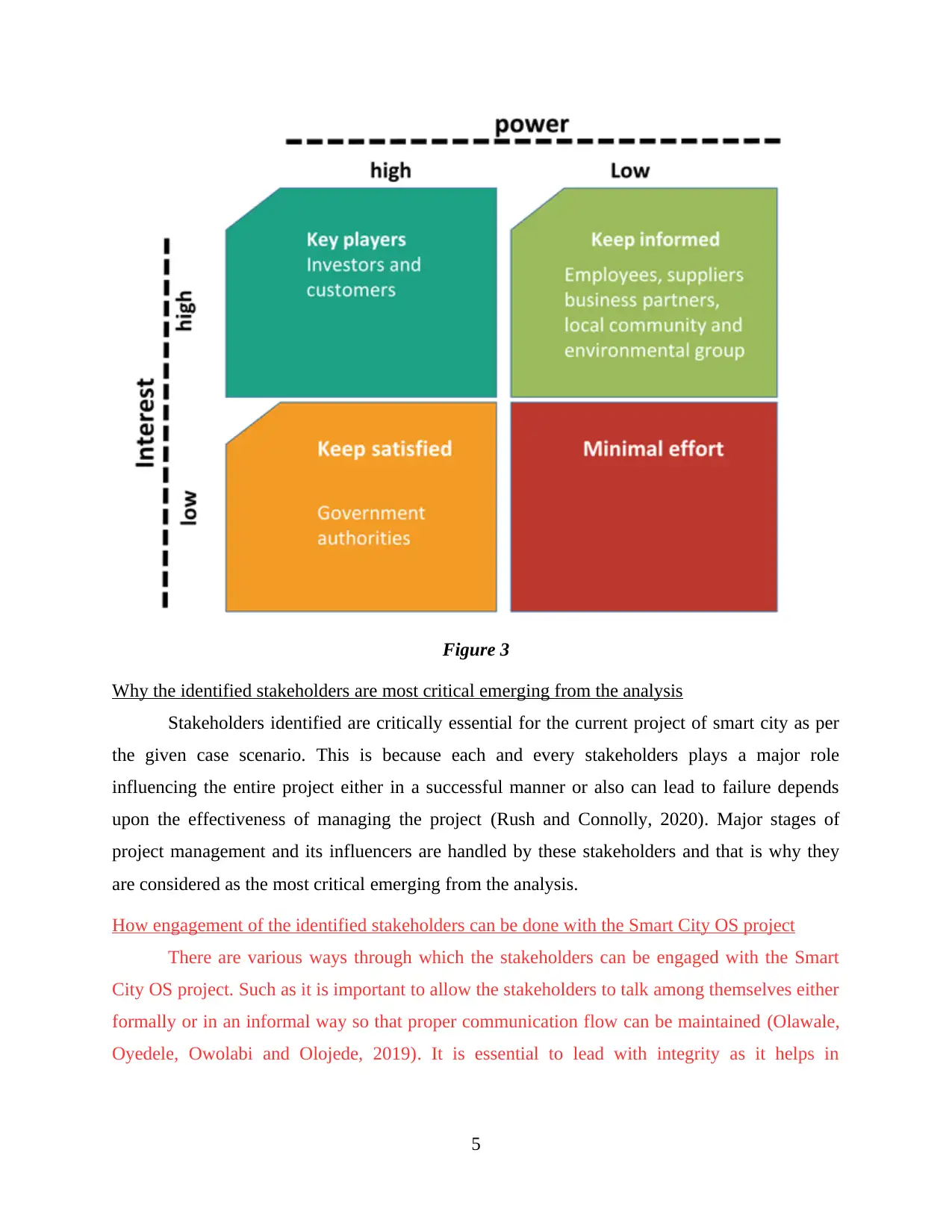
Figure 3
Why the identified stakeholders are most critical emerging from the analysis
Stakeholders identified are critically essential for the current project of smart city as per
the given case scenario. This is because each and every stakeholders plays a major role
influencing the entire project either in a successful manner or also can lead to failure depends
upon the effectiveness of managing the project (Rush and Connolly, 2020). Major stages of
project management and its influencers are handled by these stakeholders and that is why they
are considered as the most critical emerging from the analysis.
How engagement of the identified stakeholders can be done with the Smart City OS project
There are various ways through which the stakeholders can be engaged with the Smart
City OS project. Such as it is important to allow the stakeholders to talk among themselves either
formally or in an informal way so that proper communication flow can be maintained (Olawale,
Oyedele, Owolabi and Olojede, 2019). It is essential to lead with integrity as it helps in
5
Why the identified stakeholders are most critical emerging from the analysis
Stakeholders identified are critically essential for the current project of smart city as per
the given case scenario. This is because each and every stakeholders plays a major role
influencing the entire project either in a successful manner or also can lead to failure depends
upon the effectiveness of managing the project (Rush and Connolly, 2020). Major stages of
project management and its influencers are handled by these stakeholders and that is why they
are considered as the most critical emerging from the analysis.
How engagement of the identified stakeholders can be done with the Smart City OS project
There are various ways through which the stakeholders can be engaged with the Smart
City OS project. Such as it is important to allow the stakeholders to talk among themselves either
formally or in an informal way so that proper communication flow can be maintained (Olawale,
Oyedele, Owolabi and Olojede, 2019). It is essential to lead with integrity as it helps in
5
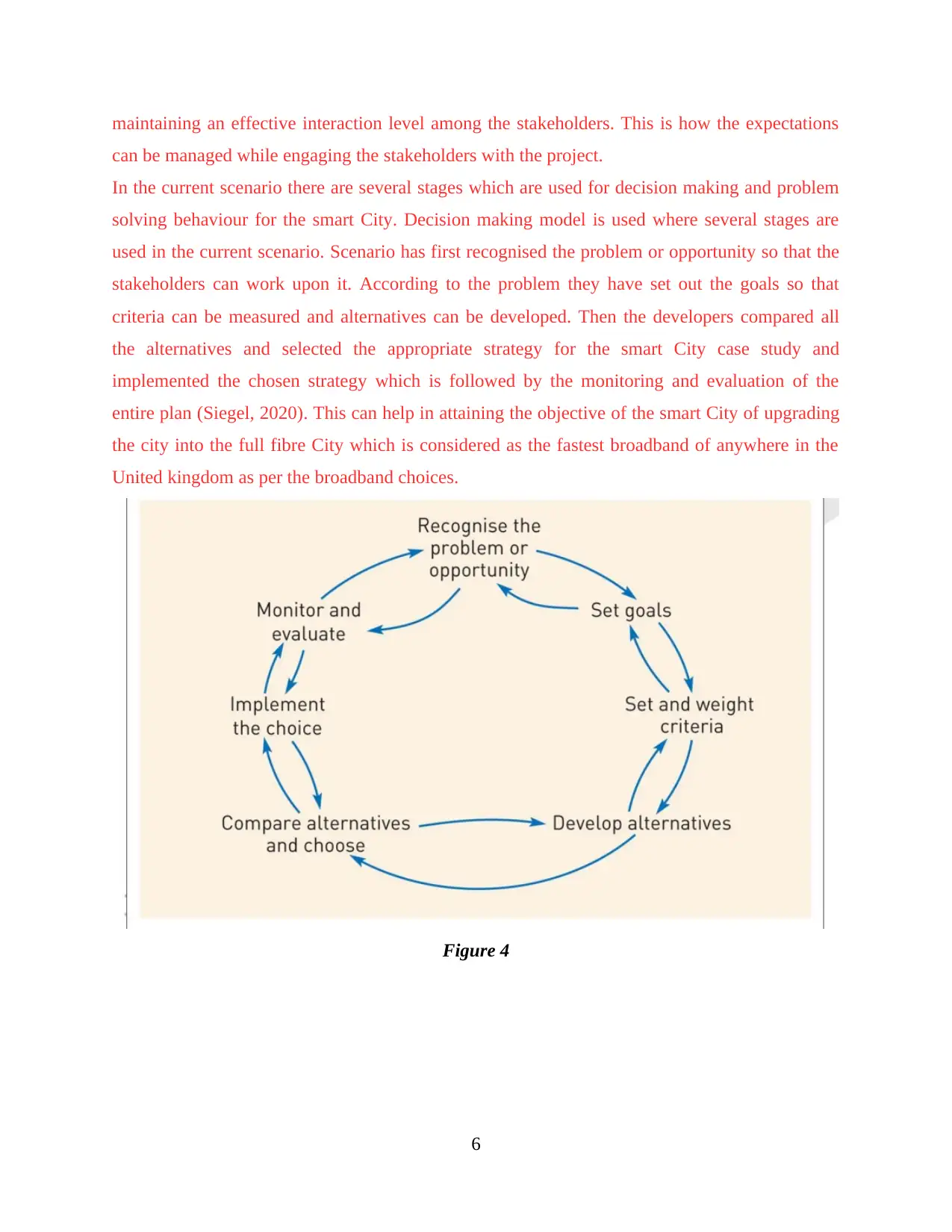
maintaining an effective interaction level among the stakeholders. This is how the expectations
can be managed while engaging the stakeholders with the project.
In the current scenario there are several stages which are used for decision making and problem
solving behaviour for the smart City. Decision making model is used where several stages are
used in the current scenario. Scenario has first recognised the problem or opportunity so that the
stakeholders can work upon it. According to the problem they have set out the goals so that
criteria can be measured and alternatives can be developed. Then the developers compared all
the alternatives and selected the appropriate strategy for the smart City case study and
implemented the chosen strategy which is followed by the monitoring and evaluation of the
entire plan (Siegel, 2020). This can help in attaining the objective of the smart City of upgrading
the city into the full fibre City which is considered as the fastest broadband of anywhere in the
United kingdom as per the broadband choices.
Figure 4
6
can be managed while engaging the stakeholders with the project.
In the current scenario there are several stages which are used for decision making and problem
solving behaviour for the smart City. Decision making model is used where several stages are
used in the current scenario. Scenario has first recognised the problem or opportunity so that the
stakeholders can work upon it. According to the problem they have set out the goals so that
criteria can be measured and alternatives can be developed. Then the developers compared all
the alternatives and selected the appropriate strategy for the smart City case study and
implemented the chosen strategy which is followed by the monitoring and evaluation of the
entire plan (Siegel, 2020). This can help in attaining the objective of the smart City of upgrading
the city into the full fibre City which is considered as the fastest broadband of anywhere in the
United kingdom as per the broadband choices.
Figure 4
6
⊘ This is a preview!⊘
Do you want full access?
Subscribe today to unlock all pages.

Trusted by 1+ million students worldwide
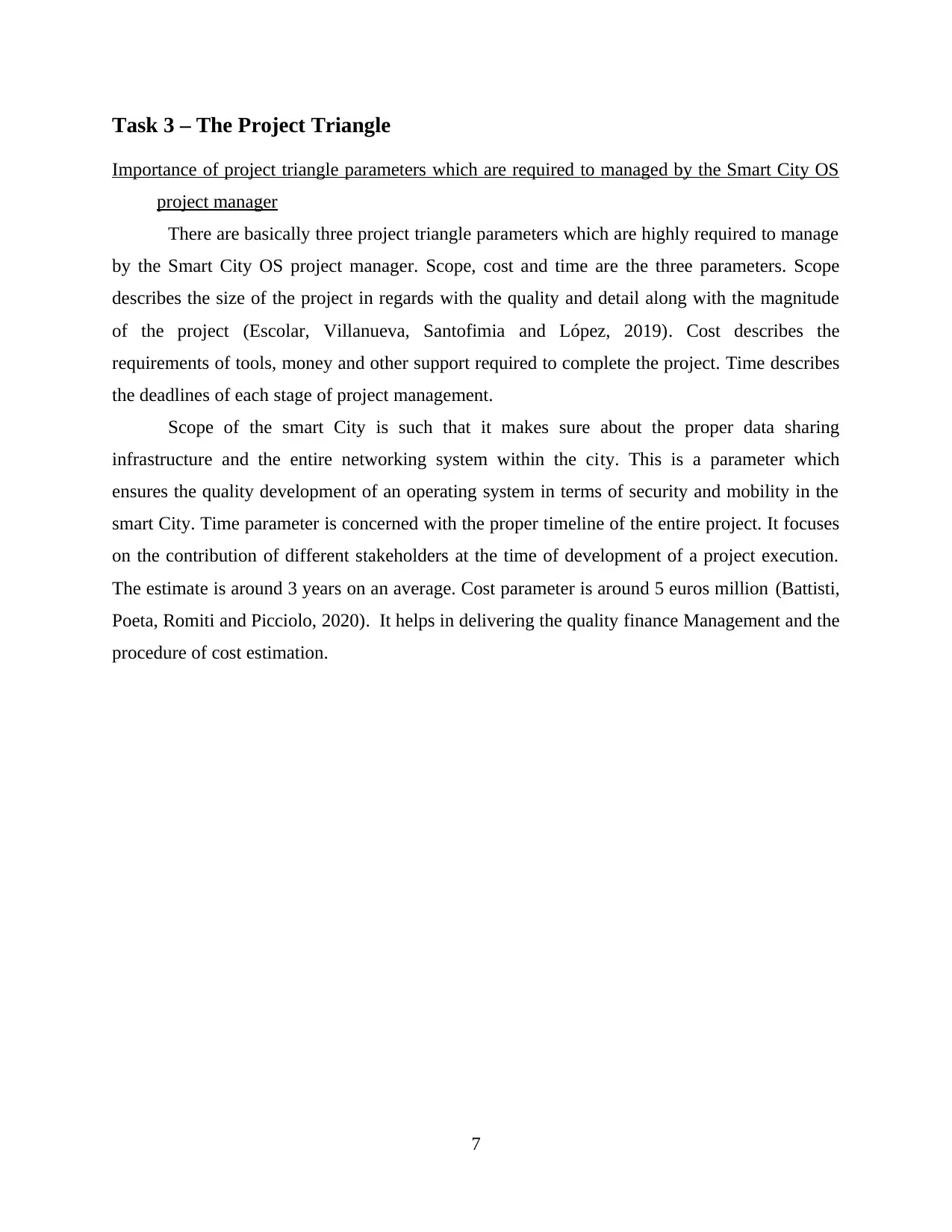
Task 3 – The Project Triangle
Importance of project triangle parameters which are required to managed by the Smart City OS
project manager
There are basically three project triangle parameters which are highly required to manage
by the Smart City OS project manager. Scope, cost and time are the three parameters. Scope
describes the size of the project in regards with the quality and detail along with the magnitude
of the project (Escolar, Villanueva, Santofimia and López, 2019). Cost describes the
requirements of tools, money and other support required to complete the project. Time describes
the deadlines of each stage of project management.
Scope of the smart City is such that it makes sure about the proper data sharing
infrastructure and the entire networking system within the city. This is a parameter which
ensures the quality development of an operating system in terms of security and mobility in the
smart City. Time parameter is concerned with the proper timeline of the entire project. It focuses
on the contribution of different stakeholders at the time of development of a project execution.
The estimate is around 3 years on an average. Cost parameter is around 5 euros million (Battisti,
Poeta, Romiti and Picciolo, 2020). It helps in delivering the quality finance Management and the
procedure of cost estimation.
7
Importance of project triangle parameters which are required to managed by the Smart City OS
project manager
There are basically three project triangle parameters which are highly required to manage
by the Smart City OS project manager. Scope, cost and time are the three parameters. Scope
describes the size of the project in regards with the quality and detail along with the magnitude
of the project (Escolar, Villanueva, Santofimia and López, 2019). Cost describes the
requirements of tools, money and other support required to complete the project. Time describes
the deadlines of each stage of project management.
Scope of the smart City is such that it makes sure about the proper data sharing
infrastructure and the entire networking system within the city. This is a parameter which
ensures the quality development of an operating system in terms of security and mobility in the
smart City. Time parameter is concerned with the proper timeline of the entire project. It focuses
on the contribution of different stakeholders at the time of development of a project execution.
The estimate is around 3 years on an average. Cost parameter is around 5 euros million (Battisti,
Poeta, Romiti and Picciolo, 2020). It helps in delivering the quality finance Management and the
procedure of cost estimation.
7
Paraphrase This Document
Need a fresh take? Get an instant paraphrase of this document with our AI Paraphraser
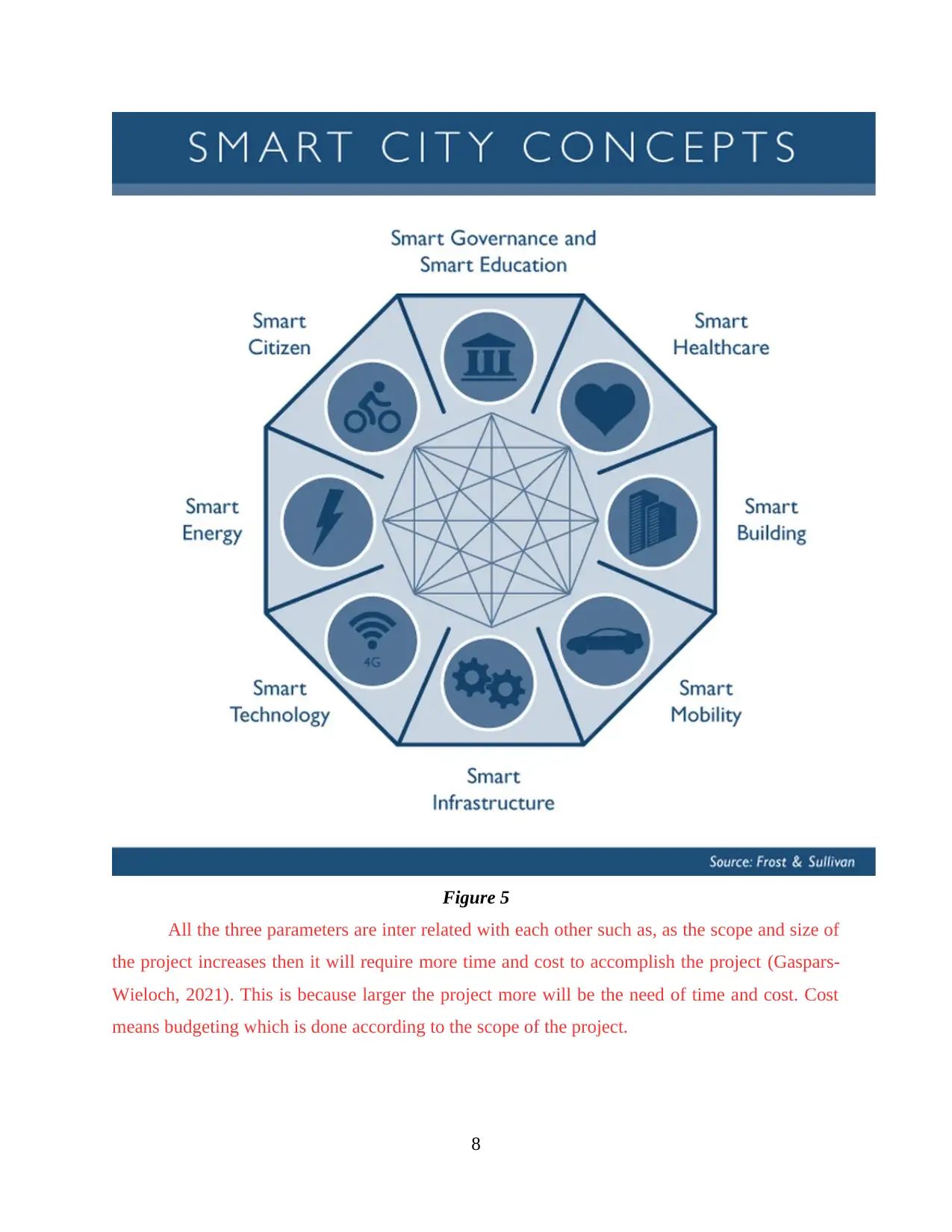
Figure 5
All the three parameters are inter related with each other such as, as the scope and size of
the project increases then it will require more time and cost to accomplish the project (Gaspars-
Wieloch, 2021). This is because larger the project more will be the need of time and cost. Cost
means budgeting which is done according to the scope of the project.
8
All the three parameters are inter related with each other such as, as the scope and size of
the project increases then it will require more time and cost to accomplish the project (Gaspars-
Wieloch, 2021). This is because larger the project more will be the need of time and cost. Cost
means budgeting which is done according to the scope of the project.
8
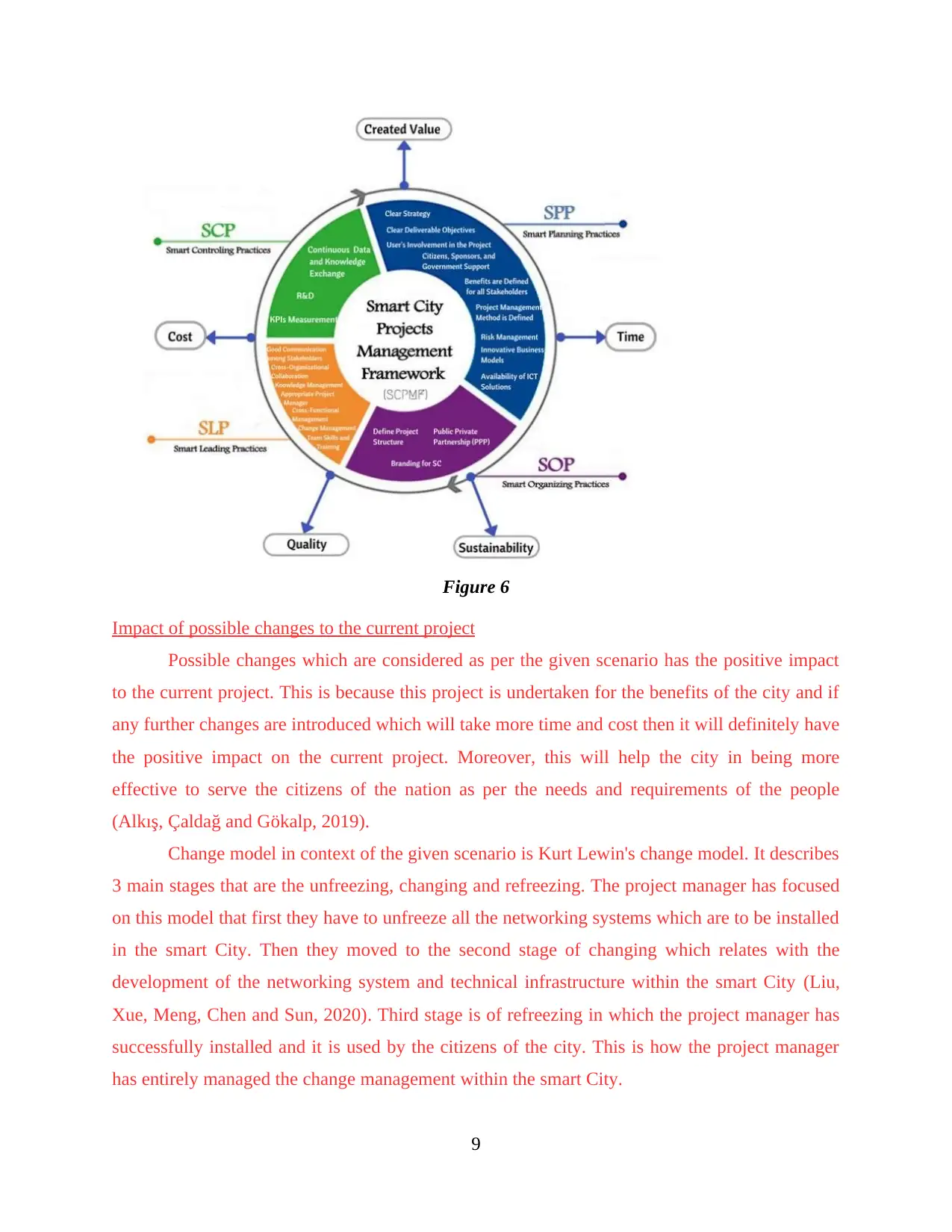
Figure 6
Impact of possible changes to the current project
Possible changes which are considered as per the given scenario has the positive impact
to the current project. This is because this project is undertaken for the benefits of the city and if
any further changes are introduced which will take more time and cost then it will definitely have
the positive impact on the current project. Moreover, this will help the city in being more
effective to serve the citizens of the nation as per the needs and requirements of the people
(Alkış, Çaldağ and Gökalp, 2019).
Change model in context of the given scenario is Kurt Lewin's change model. It describes
3 main stages that are the unfreezing, changing and refreezing. The project manager has focused
on this model that first they have to unfreeze all the networking systems which are to be installed
in the smart City. Then they moved to the second stage of changing which relates with the
development of the networking system and technical infrastructure within the smart City (Liu,
Xue, Meng, Chen and Sun, 2020). Third stage is of refreezing in which the project manager has
successfully installed and it is used by the citizens of the city. This is how the project manager
has entirely managed the change management within the smart City.
9
Impact of possible changes to the current project
Possible changes which are considered as per the given scenario has the positive impact
to the current project. This is because this project is undertaken for the benefits of the city and if
any further changes are introduced which will take more time and cost then it will definitely have
the positive impact on the current project. Moreover, this will help the city in being more
effective to serve the citizens of the nation as per the needs and requirements of the people
(Alkış, Çaldağ and Gökalp, 2019).
Change model in context of the given scenario is Kurt Lewin's change model. It describes
3 main stages that are the unfreezing, changing and refreezing. The project manager has focused
on this model that first they have to unfreeze all the networking systems which are to be installed
in the smart City. Then they moved to the second stage of changing which relates with the
development of the networking system and technical infrastructure within the smart City (Liu,
Xue, Meng, Chen and Sun, 2020). Third stage is of refreezing in which the project manager has
successfully installed and it is used by the citizens of the city. This is how the project manager
has entirely managed the change management within the smart City.
9
⊘ This is a preview!⊘
Do you want full access?
Subscribe today to unlock all pages.

Trusted by 1+ million students worldwide
1 out of 27
Related Documents
Your All-in-One AI-Powered Toolkit for Academic Success.
+13062052269
info@desklib.com
Available 24*7 on WhatsApp / Email
![[object Object]](/_next/static/media/star-bottom.7253800d.svg)
Unlock your academic potential
Copyright © 2020–2025 A2Z Services. All Rights Reserved. Developed and managed by ZUCOL.





